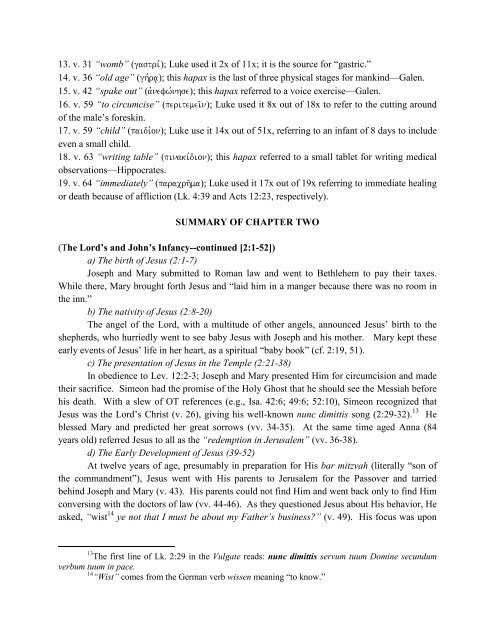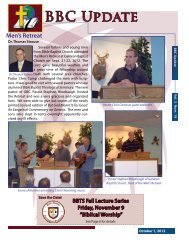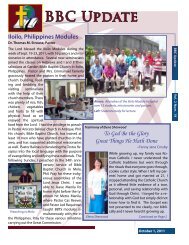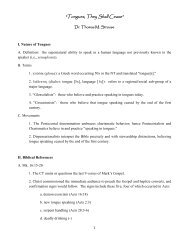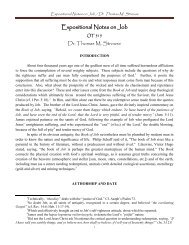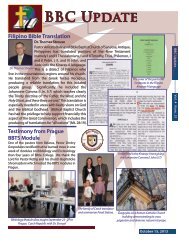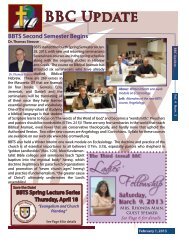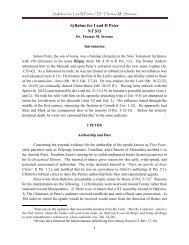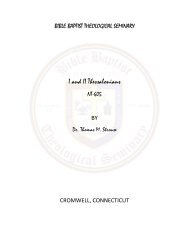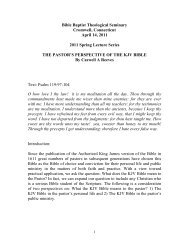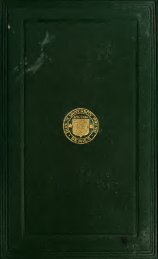Commentary on Luke's Gospel with Emphasis on Medical Terms
Commentary on Luke's Gospel with Emphasis on Medical Terms
Commentary on Luke's Gospel with Emphasis on Medical Terms
Create successful ePaper yourself
Turn your PDF publications into a flip-book with our unique Google optimized e-Paper software.
13. v. 31 “womb” (gastri,); Luke used it 2x of 11x; it is the source for “gastric.”<br />
14. v. 36 “old age” (gh,ra|); this hapax is the last of three physical stages for mankind—Galen.<br />
15. v. 42 “spake out” (avnefw,nhse); this hapax referred to a voice exercise—Galen.<br />
16. v. 59 “to circumcise” (peritemei/n); Luke used it 8x out of 18x to refer to the cutting around<br />
of the male’s foreskin.<br />
17. v. 59 “child” (paidi,<strong>on</strong>); Luke use it 14x out of 51x, referring to an infant of 8 days to include<br />
even a small child.<br />
18. v. 63 “writing table” (pinaki,di<strong>on</strong>); this hapax referred to a small tablet for writing medical<br />
observati<strong>on</strong>s—Hippocrates.<br />
19. v. 64 “immediately” (paracrh/ma); Luke used it 17x out of 19x referring to immediate healing<br />
or death because of afflicti<strong>on</strong> (Lk. 4:39 and Acts 12:23, respectively).<br />
SUMMARY OF CHAPTER TWO<br />
(The Lord’s and John’s Infancy--c<strong>on</strong>tinued [2:1-52])<br />
a) The birth of Jesus (2:1-7)<br />
Joseph and Mary submitted to Roman law and went to Bethlehem to pay their taxes.<br />
While there, Mary brought forth Jesus and “laid him in a manger because there was no room in<br />
the inn.”<br />
b) The nativity of Jesus (2:8-20)<br />
The angel of the Lord, <strong>with</strong> a multitude of other angels, announced Jesus’ birth to the<br />
shepherds, who hurriedly went to see baby Jesus <strong>with</strong> Joseph and his mother. Mary kept these<br />
early events of Jesus’ life in her heart, as a spiritual “baby book” (cf. 2:19, 51).<br />
c) The presentati<strong>on</strong> of Jesus in the Temple (2:21-38)<br />
In obedience to Lev. 12:2-3; Joseph and Mary presented Him for circumcisi<strong>on</strong> and made<br />
their sacrifice. Sime<strong>on</strong> had the promise of the Holy Ghost that he should see the Messiah before<br />
his death. With a slew of OT references (e.g., Isa. 42:6; 49:6; 52:10), Sime<strong>on</strong> recognized that<br />
Jesus was the Lord’s Christ (v. 26), giving his well-known nunc dimittis s<strong>on</strong>g (2:29-32). 13 He<br />
blessed Mary and predicted her great sorrows (vv. 34-35). At the same time aged Anna (84<br />
years old) referred Jesus to all as the “redempti<strong>on</strong> in Jerusalem” (vv. 36-38).<br />
d) The Early Development of Jesus (39-52)<br />
At twelve years of age, presumably in preparati<strong>on</strong> for His bar mitzvah (literally “s<strong>on</strong> of<br />
the commandment”), Jesus went <strong>with</strong> His parents to Jerusalem for the Passover and tarried<br />
behind Joseph and Mary (v. 43). His parents could not find Him and went back <strong>on</strong>ly to find Him<br />
c<strong>on</strong>versing <strong>with</strong> the doctors of law (vv. 44-46). As they questi<strong>on</strong>ed Jesus about His behavior, He<br />
asked, “wist 14 ye not that I must be about my Father’s business?” (v. 49). His focus was up<strong>on</strong><br />
13<br />
The first line of Lk. 2:29 in the Vulgate reads: nunc dimittis servum tuum Domine secundum<br />
verbum tuum in pace.<br />
14<br />
“Wist” comes from the German verb wissen meaning “to know.”


